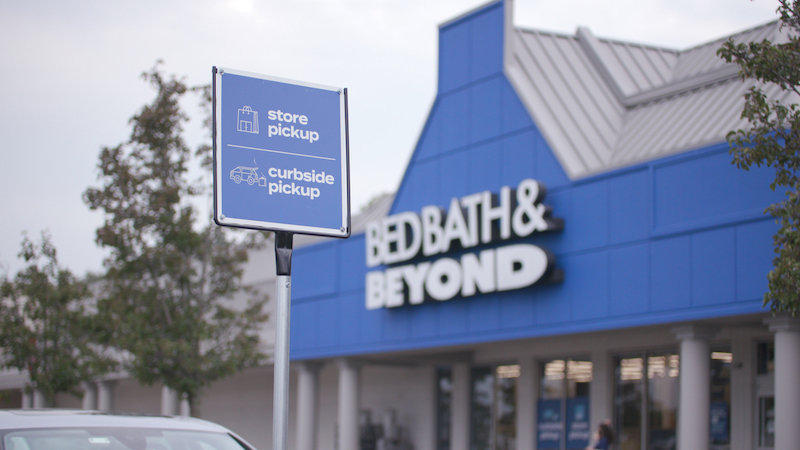Bed Bath & Beyond files for bankruptcy

After months of speculation, housewares retailer Bed Bath & Beyond has filed a bankruptcy petition, after years of net losses and changing consumer habits.
The company announced Sunday that it filed a Chapter 11 case in the United States Bankruptcy Court for the District of New Jersey. If it doesn’t find a last-minute buyer, it will liquidate and all 360 Bed Bath & Beyond stores will close following bankruptcy proceedings.
“Thank you to all of our loyal customers,” a banner at the top of the Bed Bath & Beyond website currently reads. “We have made the difficult decision to begin winding down our operations.”
“We deeply appreciate our associates, customers, partners, and the communities we serve, and we remain steadfastly determined to serve them throughout this process,” wrote Sue Gove, president & CEO, in a statement. “We will continue working diligently to maximize value for the benefit of all stakeholders.”
The Bed Bath & Beyond company also operates the buybuy Baby chain, which has seen stronger performance than the main brand. The company said all 120 buybuy Baby stores will also shutter unless it’s able to sell the retail business.
Bed Bath & Beyond was once considered a staple in suburban shopping centers with nearly 1,000 stores nationwide as of mid-2022. But it began to lose its footing in recent years as shoppers’ habits changed. E-commerce chipped away at sales as well as the proliferation of DTC housewares businesses that could be more nimble to customers’ changing behaviors.
Bed Bath & Beyond’s fourth-quarter earnings report showed $2.05 billion in net sales, a decline of 22% from the year before, and 33% from the year before, and $159 million. In the third quarter, sales dropped 33% and the company racked up $450 million in operating losses. Last January, it reported $1.1 billion in net losses for the first nine months of the fiscal year, up from $400.5 million a year prior.
But the financial problems go beyond sales and losses: At its most recent earnings, the company’s total liabilities hit $2.1 billion, with long-term debt at $1.2 billion. The Wall Street Journal reported on Feb.1 that the company failed to make interest payments on bonds.
The much-anticipated bankruptcy filing follows impending closures of Bed Bath and Beyond stores across the country in recent months. On Jan. 30, the company confirmed the closure of 87 Bed Bath & Beyond locations, five buybuy Baby stores, plus all 49 of its Harmon stores. “This store fleet reduction expands the Company’s ongoing closure program of approximately 150 lower-producing Bed Bath & Beyond banner stores,” the company said in a media statement.
In February, the company raised $225 million in an emergency stock sale, and said it may be able to raise an additional $800 million over the rest of the year. That clearly didn’t happen, as only two months later the company opted to make this latest bankruptcy move.
The announcement arrives after years of net losses, new merchandising strategies and cuts to operations. In addition to leadership shake-ups and a sprawling private-label strategy, Bed Bath & Beyond also took steps to improve its e-commerce presence, upgrade its stores and launched a membership program. But any gains weren’t fast or large enough to turn the operations around, leaving the company on the hook for its debts without a profitable revenue stream.
The retail said in its announcement that it has “received a commitment of approximately $240 million in debtor-in-possession financing (“DIP”) from Sixth Street Specialty Lending, Inc.”
John Sparacino, a principal with law firm McKool Smith’s restructuring practice who is not related to the case, said ahead of the filing that there was little the company could do to turn things around — especially once it started missing debt payments.
“For any business like this with a lot of debt, the real trigger point comes when you either have maturities coming due or you have big bond coupon payments coming due or big debt service interest payments coming due,” he said. “Once those start to happen, you’ve got to get into bankruptcy to kind of keep it all together before the lenders pull it apart.”
Other options are hard to come by. The current fiscal environment would make a new infusion of equity difficult to attain. And despite the brands’ ubiquitous coupons, “they’re not going to sell their way out of the problem right now,’ Sparacino said. Still, in the months leading up to the filing, shoppers still were receiving coupons via text, email and in the mail.
Decisions to enter Chapter 11, though, are not made lightly. Retailers assemble teams of advisors – in this case, Bed Bath and Beyond worked with Kirkland & Ellis, Cole Schotz P.C., AlixPartners LLP and Lazard Frères & Co. LLC on its plan.
Some of that prep work also includes reaching out to creditor groups to get them onboard with the plan, Sparacino said. Other major stakeholders in the Bed Bath & Beyond case might be vendors, landlords and inventory suppliers.
But getting in touch with stakeholders ahead of the filing ensures the company has a solid plan to present to the judge. Elements of that plan might look like shutting down stores — as bankruptcy may provide an avenue to terminate leases — or making adjustments to its capital structure in order to turn its debt into equity to satisfy the debt holders.
“Some of the existing debt holders are going to come out at the end of Chapter 11 process owning, probably, a much skinnier retail operation,” Sparacino said.

